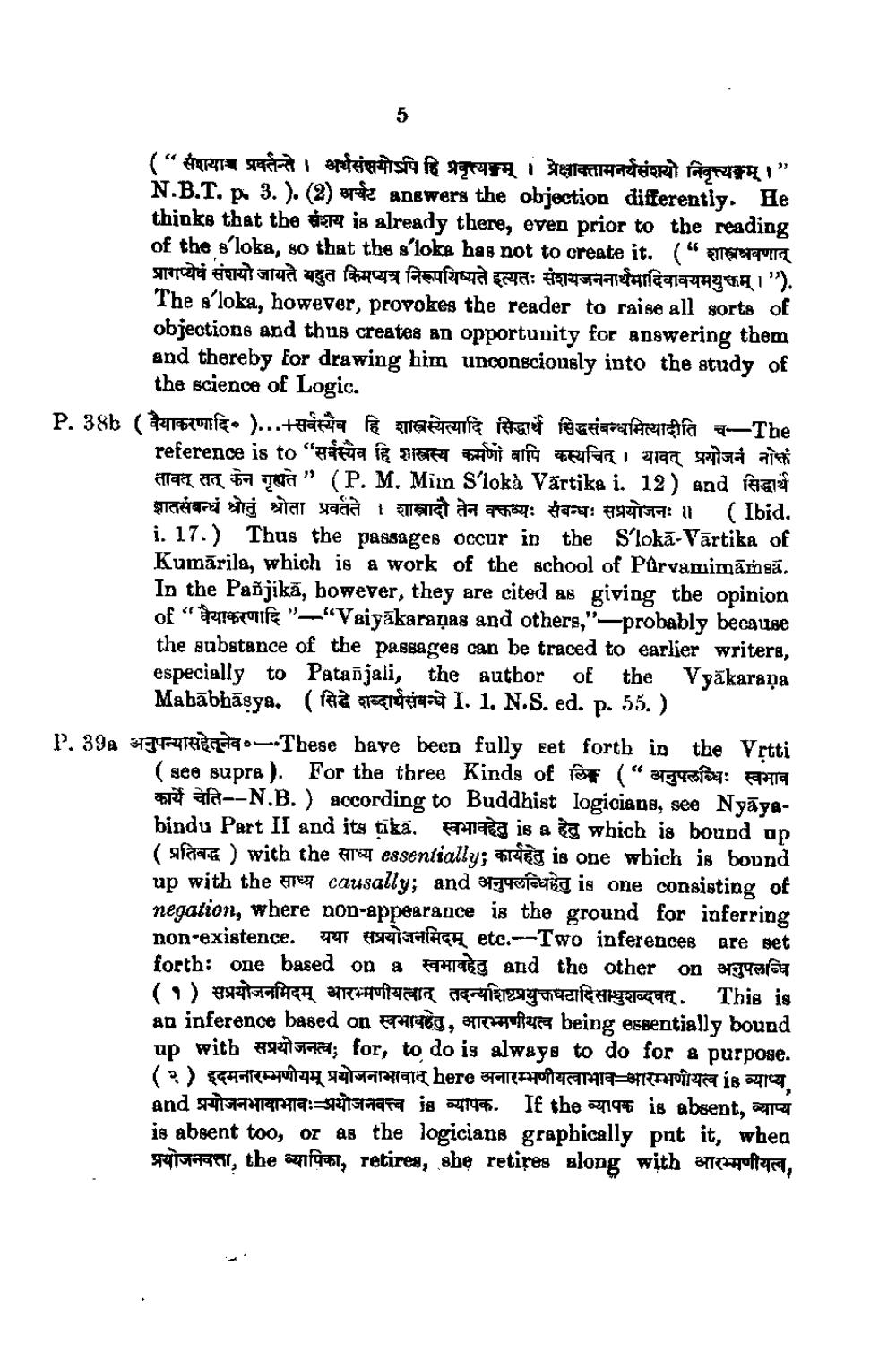________________
(“ संशयाच प्रवर्तन्ते । अर्थसंशयोऽपि हि प्रवृत्याम् । प्रेक्षाक्तामनसंश्यो निवृत्त्यकम् ।"
N.B.T. p. 3.). (2) अर्चट answers the objection differentiy. He thinks that the T is already there, even prior to the reading of the sloka, so that the sloka has not to create it. (“ शास्त्रश्रवणात् प्रागप्येवं संशयो जायते यदुत किमप्यत्र निरूपयिष्यते इत्यतः संशयजननार्थमादिवाक्यमयुक्तम्।"). The a'loka, however, provokes the reader to raise all sorts of objections and thus creates an opportunity for answering them and thereby for drawing him unconsciously into the study of
the science of Logic. P. 38b (वैयाकरणादि.)...+सर्वस्यैव हि शास्त्रस्यत्यादि सिद्धार्थ सिद्धसंबन्धमित्यादीति च-The
reference is to “सर्वस्यैव हि शास्त्रस्य कर्मणों वापि कस्यचित् । यावत् प्रयोजनं नातं तावत् सत् केन गृह्यते" (P. M. Mim Sloka Vartika i. 12) and सिद्धार्थ ज्ञातसंबन्धं श्रोतुं श्रोता प्रवर्तते । शास्त्रादौ तेन वक्तव्यः संबन्धः सप्रयोजनः ॥ (Ibid. i. 17.) Thus the passages occur in the S'lokā-Vārtika of Kumārila, which is a work of the school of Purvamimāmsă. In the Pañjikā, bowever, they are cited as giving the opinion of "वैयाकरणादि "-"Vaiyakaranas and others,"-probably because the substance of the passages can be traced to earlier writers, especially to Patanjali, the author of the Vyäkarana
Mahābhāsya. (सिद्ध शब्दार्थसंबन्धे I. 1. N.S.ed. p. 55.) P. 399 अनुपन्यासहेतूनेव.--These have been fully Eet forth in the Vrtti
(see supra). For the three Kinds of लिक (“ अनुपलब्धिः स्वभाव कार्ये चेति--N.B.) according to Buddhist logicians, see Nyayabindu Part II and its tikā. स्वभावहेतु is a हेतु which is bound up (प्रतिबद्ध ) with the साध्य essentially; कार्यहेतु is one which is bound up with the per causally; and sigurarea is one consisting of negation, where non-appearance is the ground for inferring non-existence. यथा सप्रयोजनमिदम् etc.--Two inferences are set forth: one based on a स्वभावहेतु and the other on अनुपलब्धि (1) सप्रयोजनमिदम् आरभ्मणीयत्वात् तदन्यशिष्टप्रयुक्तघटादिसाधुशब्दवत् . This is an inference based on स्वभावहेतु, आरभ्मणीयत्व being essentially bound up with सप्रयोजनत्व; for, to do is always to do for a purpose. (२) इदमनारम्भणीयम् प्रयोजनाभावात् here अनारम्भणीयत्वाभाव-आरम्भणीयत्व 18 व्याप्य and प्रयोजनभावाभावः अयोजनवत्त्व is व्यापक. If the व्यापक is absent, व्याप्य is absent too, or as the logicians graphically put it, when प्रयोजनवत्ता, the व्यापिका, retires, she retires along with आरभ्मणीयत्व,




